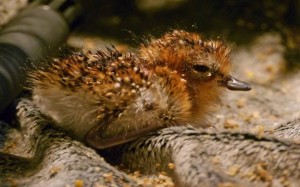
Interviews available with Nigel Jarrett and the team in Anadyr, Russia, by telephone
Contact WWT Media Team to arrange an interview on 01453 891176/138/144
The first critically endangered spoon-billed sandpiper to hatch in captivity in the world was always going to be a spectacular sight, but when a Heritage Expeditions boat docked in Anadyr last night not one, not two, but an incredible 17 tiny, hatched spoon-billed sandpiper chicks emerged.
The incredibly ambitious mission to collect eggs from the rapidly dwindling number of nests on the breeding grounds in Chukotka and transport them thousands of miles via land, sea and air to the conservation breeding facility at WWT Slimbridge hatching has reached an important milestone.
Incredibly eight of the chicks actually hatched just as the team were preparing to leave Chukotka. Describing his elation on docking safely in Anadyr, WWT’s Head of Conservation Breeding, Nigel Jarrett said: “We boarded the boat with the eight newly hatched chicks, 12 fertile eggs, considerable anxiety about the trip on rough seas and a great deal of hope. We got off the other end with only three eggs, but an amazing 17 chicks and the remaining eggs poised to hatch any day, so I am as happy as happy can be.”
Things have gone as well as could possibly have been hoped for so far, but saving this species is still going to be an uphill battle. A couple of the hatchlings aren’t quite as strong as the others and we will have to accept that we will lose some.
The survival rate for spoon-billed sandpiper chicks in the wild is extremely low. On average just four chicks fledge out of around 20 eggs laid and only one of these would survive to recruit into the adult population two years later. Taking these newly hatched chicks from hatching to fledging will be enough of a challenge on its own. However, even this is dwarfed by the work that we and our partners need to do to tackle the threats to the species in the wild (see Editor’s Notes).
Elizabeth Tambovtseva from Birds Russia is part of the team on the expedition. She said: “The excitement from the team when the first egg hatched and a tiny chick appeared was off the scale – we haven’t slept for days with the stress and worry so it was a pretty emotional experience. All the partners have been working hard as a team to pull off this very important stage of the mission and it’s paid off. I didn’t get a chance to celebrate my birthday last week, but this belated present more than makes up for that!”
The conservation breeding expedition, led by staff from the Wildfowl & Wetlands Trust (WWT) and Birds Russia, has support from the RSPB, BTO, BirdLife International, ArcCona, the Spoon-billed Sandpiper Task Force and Moscow Zoo. The project is funded by WWT and RSPB, with additional financial contributions and support from BirdLife International, the East-Asian Australasian Flyway Partnership, the Convention on Migratory Species, Heritage Expeditions and the Australasian Wader Study Group of Birds Australia.

WWT has launched a public fundraising appeal to save the spoon-billed sandpiper www.wwt.org.uk/
